Sales of longevity supplements in the European Union are estimated at USD 500 million in 2025, with projections indicating a rise to USD 1.23 billion by 2035, reflecting a CAGR of approximately 9.4% over the forecast period. This growth reflects both a broadening consumer base and increased per capita spending in key metropolitan centres.
The rise in demand is linked to shifting wellness priorities, growing awareness of preventive healthcare, and evolving aging demographics. By 2025, per capita spending in leading EU countries such as Germany, France, and Netherlands averages between USD 8.2 to USD 9.7, with projections reaching USD 18.4 by 2035. London leads among metropolitan areas, expected to generate USD 147 million in longevity supplement sales by 2035, followed by Paris (USD 89 million), Berlin (USD 67 million), Amsterdam (USD 52 million), and Milan (USD 41 million).
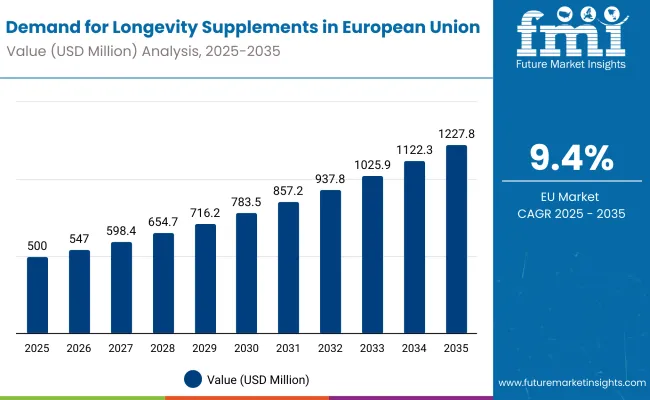
The largest contribution to demand continues to come from anti-aging peptides, which are expected to account for 64% of total sales in 2025, owing to strong clinical backing, proven efficacy, and healthcare practitioner endorsement. By distribution channel, specialty health stores represent the dominant retail format, responsible for 51% of all sales, while online direct-to-consumer platforms and wellness clinics are expanding rapidly.
Consumer adoption is particularly concentrated among affluent urban professionals and health-conscious Gen X consumers, with income and education emerging as significant drivers of demand. While price remains a consideration, the average spending per consumer has increased from USD 127 in 2020 to USD 183 in 2025. Continued improvements in bioavailability and personalized formulations are expected to accelerate adoption across middle-income households. Regional disparities persist, but per capita spending in emerging wellness hubs in Eastern Europe is narrowing the gap with traditionally strong Western European centres.
The longevity supplements segment in the EU is classified across several segments. By product, the key categories include anti-aging peptides, cellular repair compounds, mitochondrial enhancers, and telomere support formulations. By distribution channel, the segment spans specialty health stores, online direct-to-consumer platforms, wellness clinics and anti-aging centers, pharmacies, and premium supplement retailers. By active ingredient, formulations include NAD+ precursors, resveratrol and polyphenols, peptide complexes, stem cell activators, and novel longevity compounds such as spermidine, fisetin, and senolytic blends.
By consumer profile, the segment covers affluent urban professionals, health-conscious Gen X consumers, biohacking enthusiasts, preventive wellness seekers, and individuals with age-related health concerns. By region, countries such as Germany, France, United Kingdom, Netherlands, and Italy are included, along with coverage across all 27 EU member states plus UK and Switzerland. By city, key metro areas analyzed include London, Paris, Berlin, Amsterdam, and Milan.
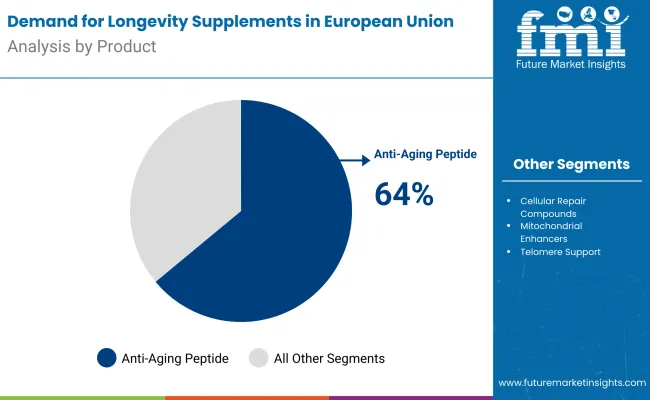
Anti-aging peptides are projected to dominate sales in 2025, supported by clinical research validation, practitioner recommendations, and premium positioning. Other formats such as cellular repair compounds, mitochondrial enhancers, and telomere support are growing steadily, each serving distinct health optimization needs.
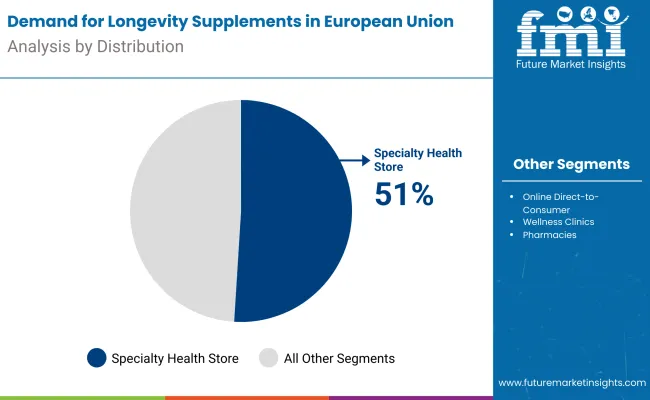
Longevity supplements in the EU are distributed through a mix of specialized wellness retail and alternative sales channels. Specialty health stores are expected to remain the primary point of sale in 2025, followed by online platforms and wellness clinics. Distribution strategies are evolving to match consumer buying behavior, with growth coming from both specialized physical and digital formats.
Longevity supplements in the EU utilize a variety of active ingredients, selected for bioavailability, clinical evidence, mechanism of action, and safety profile. NAD+ precursors remain the most widely used longevity compounds, though alternatives like resveratrol and peptide complexes are gaining momentum. Product developers are increasingly exploring novel compounds and synergistic blends to meet evolving consumer and practitioner demands.
The longevity supplements category appeals to a distinct consumer base across age groups, income levels, and wellness approaches. While motivations vary from preventive health to performance optimization to age reversal, demand is concentrated among five key demographic clusters. Each group brings distinct purchase behaviors, channel preferences, and product expectations.
Germany leads the market with an expected CAGR of 3.2%, followed by France (3%), the United Kingdom (2.9%), and the Netherlands (2.8%), while Italy shows the slowest growth at 2.6%. This pattern highlights a strong yet uneven adoption across major EU economies, with Germany driving momentum due to its large health-conscious population and established nutraceutical industry, while southern markets like Italy are growing at a more modest pace.
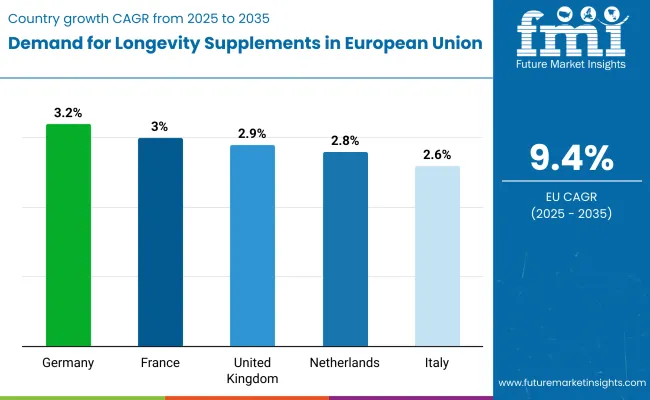
Longevity supplement sales will not grow uniformly across every metropolitan area. Rising wealth concentration and faster per-capita adoption in emerging wellness hubs give Berlin and Amsterdam a measurable edge, while mature Western European centres such as London expand more steadily from a higher base. The table below shows the compound annual growth rate (CAGR) each of the five largest cities is expected to record between 2025 and 2035.
Between 2025 and 2035, demand for longevity supplements is projected to expand across all major EU metropolitan areas, but the pace of growth will vary based on demographic shifts, wellness infrastructure penetration, and baseline consumption levels. Among the top five cities analyzed, Berlin and Amsterdam are expected to register the fastest compound annual growth rate (CAGR) of 3.1%, outpacing more mature wellness hubs.
This acceleration is underpinned by a combination of factors: growing tech professional populations, expanding wellness clinic networks, and increasing availability of premium longevity brands across specialized retailers and online platforms. In both cities, per capita spending is projected to rise from USD 8.9 in 2025 to USD 12.1 by 2035, closing the gap with higher-spending cities such as London and Paris. Retail assortment is also expanding faster in these regions, with new direct-to-consumer brands and personalized formulations gaining traction in wellness centers and premium supplement stores.
Milan and Paris are each forecast to grow at a CAGR of 2.8% over the same period. Both cities already maintain established wellness ecosystems, with widespread access to premium longevity supplements in specialty stores, pharmacies, and anti-aging clinics. In Milan, growth is supported by a strong luxury wellness consumer base, brand experimentation, and increasing uptake of Italian-formulated premium products. Paris reflects similar dynamics, particularly among health-conscious professionals and wellness-oriented consumers seeking science-backed anti-aging solutions. In both cities, per capita spending is projected to increase from USD 9.4 in 2025 to USD 12.8 by 2035, reflecting mainstreaming of longevity wellness approaches.
London, while maintaining the highest overall sales in absolute terms, is expected to grow at a CAGR of 2.5%, slightly below its continental counterparts. The city already exhibits higher-than-average per capita spending (USD 10.2 in 2025), extensive product saturation, and a dense wellness retail network. Growth will likely come from repeat purchasing, new personalized formulations, and premium clinic expansion rather than first-time trial.
Collectively, these five metro areas represent the core of urban demand for longevity supplements in the EU, but their individual growth paths highlight the importance of regional tailoring in pricing, formulation development, and channel strategy.
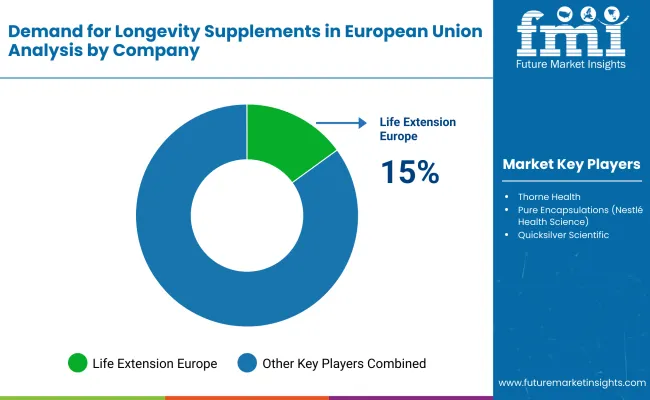
The competitive environment is characterized by a mix of established supplement manufacturers and newer, longevity-specialized entrants. Distribution breadth rather than sheer product count remains the decisive success factor: the five largest suppliers collectively reach more than 15,000 retail outlets across the EU and account for a majority of premium shelf facings in the category.
Life Extension Europe is the most established participant. The European arm of the US-based company offers more than 180 longevity-focused SKUs, all backed by clinical research and third-party testing. Its core range of anti-aging formulations gives it deep penetration in specialty health stores while maintaining strong presence through premium online channels and wellness practitioner networks.
Thorne Health leverages its clinical reputation and practitioner relationships to place science-backed longevity supplements in wellness clinics, anti-aging centers, and premium health stores. Post-European expansion gains in regulatory compliance have allowed Thorne to introduce personalized supplement protocols priced at premium levels, reinforcing its role as the preferred choice for healthcare practitioners.
Pure Encapsulations, owned by Nestle Health Science, benefits from scale synergies inside a global wellness portfolio and from established European distribution networks. Recent launches under the longevity-focused product lines extend Pure Encapsulations beyond basic supplements into targeted anti-aging formulations expressly targeting the longevity-conscious consumer.
The next tier comprises specialist and emerging longevity companies. Quicksilver Scientific focuses on liposomal delivery systems and advanced bioavailability; recent European expansion showed quarterly sales growth of 28%, signaling strong but still niche scale. Designs for Health adds targeted longevity protocols to its practitioner-focused distribution and is expected to benefit from increasing wellness clinic adoption.
Private-label programs at major health retailers are widening assortment at price points 15-20% below branded equivalents, putting margin pressure on smaller suppliers while supporting category trial. Consolidation is therefore likely to continue as clinical validation and omnichannel reach become critical for maintaining shelf visibility and practitioner recommendation in this science-driven category.
The market is valued at USD 500 million in 2025 and projected to reach USD 1.23 billion by 2035, expanding at a CAGR of 9.4%.
Anti-aging peptides dominate with a 64% share in 2025, driven by strong clinical validation and practitioner endorsements.
Specialty health stores lead distribution with a 51% share in 2025, supported by expert consultations and premium product placement.
Berlin and Amsterdam are forecast to grow the fastest with a CAGR of 3.1% (2025 to 2035), supported by rising wellness infrastructure and tech-driven demographics.
Leading companies include Life Extension Europe, Thorne Health, Pure Encapsulations (Nestlé Health Science), Jarrow Formulas Europe, Designs for Health, and Quicksilver Scientific.






Our Research Products

The "Full Research Suite" delivers actionable market intel, deep dives on markets or technologies, so clients act faster, cut risk, and unlock growth.

The Leaderboard benchmarks and ranks top vendors, classifying them as Established Leaders, Leading Challengers, or Disruptors & Challengers.

Locates where complements amplify value and substitutes erode it, forecasting net impact by horizon

We deliver granular, decision-grade intel: market sizing, 5-year forecasts, pricing, adoption, usage, revenue, and operational KPIs—plus competitor tracking, regulation, and value chains—across 60 countries broadly.

Spot the shifts before they hit your P&L. We track inflection points, adoption curves, pricing moves, and ecosystem plays to show where demand is heading, why it is changing, and what to do next across high-growth markets and disruptive tech

Real-time reads of user behavior. We track shifting priorities, perceptions of today’s and next-gen services, and provider experience, then pace how fast tech moves from trial to adoption, blending buyer, consumer, and channel inputs with social signals (#WhySwitch, #UX).

Partner with our analyst team to build a custom report designed around your business priorities. From analysing market trends to assessing competitors or crafting bespoke datasets, we tailor insights to your needs.
Supplier Intelligence
Discovery & Profiling
Capacity & Footprint
Performance & Risk
Compliance & Governance
Commercial Readiness
Who Supplies Whom
Scorecards & Shortlists
Playbooks & Docs
Category Intelligence
Definition & Scope
Demand & Use Cases
Cost Drivers
Market Structure
Supply Chain Map
Trade & Policy
Operating Norms
Deliverables
Buyer Intelligence
Account Basics
Spend & Scope
Procurement Model
Vendor Requirements
Terms & Policies
Entry Strategy
Pain Points & Triggers
Outputs
Pricing Analysis
Benchmarks
Trends
Should-Cost
Indexation
Landed Cost
Commercial Terms
Deliverables
Brand Analysis
Positioning & Value Prop
Share & Presence
Customer Evidence
Go-to-Market
Digital & Reputation
Compliance & Trust
KPIs & Gaps
Outputs
Full Research Suite comprises of:
Market outlook & trends analysis
Interviews & case studies
Strategic recommendations
Vendor profiles & capabilities analysis
5-year forecasts
8 regions and 60+ country-level data splits
Market segment data splits
12 months of continuous data updates
DELIVERED AS:
PDF EXCEL ONLINE
Comprehensive Analysis of Europe Pet Food Supplements Market by Nature, Form, Pet Type and Distribution Channel through 2035
Western Europe Dietary Supplements Market Analysis by Ingredients, Form, Application, and Country Through 2025 to 2035
Demand for Dietary Supplements in EU Size and Share Forecast Outlook 2025 to 2035
Demand for Calcium Supplements in EU Size and Share Forecast Outlook 2025 to 2035
Demand for Fertility Supplements in EU Size and Share Forecast Outlook 2025 to 2035
Demand for Probiotic Supplements in EU Size and Share Forecast Outlook 2025 to 2035
Demand for Postbiotic Supplements in EU Size and Share Forecast Outlook 2025 to 2035
Demand and Sales Analysis of Paper Cup in Western Europe Size and Share Forecast Outlook 2025 to 2035
Demand for Postnatal Health Supplements in EU Size and Share Forecast Outlook 2025 to 2035
Sales Platforms Software Market Size and Share Forecast Outlook 2025 to 2035
Europe Radiotherapy Patient Positioning Market Size and Share Forecast Outlook 2025 to 2035
Salesforce Services Market Size and Share Forecast Outlook 2025 to 2035
Europe Polyvinyl Alcohol Industry Analysis Size and Share Forecast Outlook 2025 to 2035
Europe Cruise Market Forecast and Outlook 2025 to 2035
Europium Market Forecast and Outlook 2025 to 2035
Sales Analysis of Tourism Industry in the Middle East Size and Share Forecast Outlook 2025 to 2035
Eucommia Leaf Extract Market Size and Share Forecast Outlook 2025 to 2035
Europe Massage Therapy Service Market Size and Share Forecast Outlook 2025 to 2035
Europe Cement Market Analysis Size and Share Forecast Outlook 2025 to 2035
European Union Tourism Industry Size and Share Forecast Outlook 2025 to 2035

Thank you!
You will receive an email from our Business Development Manager. Please be sure to check your SPAM/JUNK folder too.
Chat With
MaRIA